
Table of
Contents
 Table of Contents |
This chapter uses two different scenarios to
illustrate how the collection management process and tools may
be applied to focus collection on fulfilling the commander's intelligence
requirements.
The scenarios begin with a heavy corps planning
an attack in an optimum collection environment in terms of weather,
targets, and terrain (Figure 4-1 through Figure 4-19).
The second scenario highlights the collection
considerations of a force projection brigade during a JTF deployment
(Figure 4-20 through 4-34).
Both scenarios present intelligence collection
challenges that call for a clear understanding of the collection
management process and functions. The mission, echelon, and collection
environment differ in each case, but the same process applies.
The techniques and tools shown may be modified to suit any situation.
This chapter offers the collection manager optional approaches
to applying the collect ion management process; it does not provide
"approved school solutions."
Scenario One - Corps Conventional
Offense
Operation PLAINS PUSH calls for IV Corps as a
part of the Army of the Red River to make the Theater's main effort
in an offense to seize OBJ TOM. The enemy's forward defensive
positions, thinly held by several mechanized infantry divisions,
are backed up by strong reserves (see Figure 4-1).
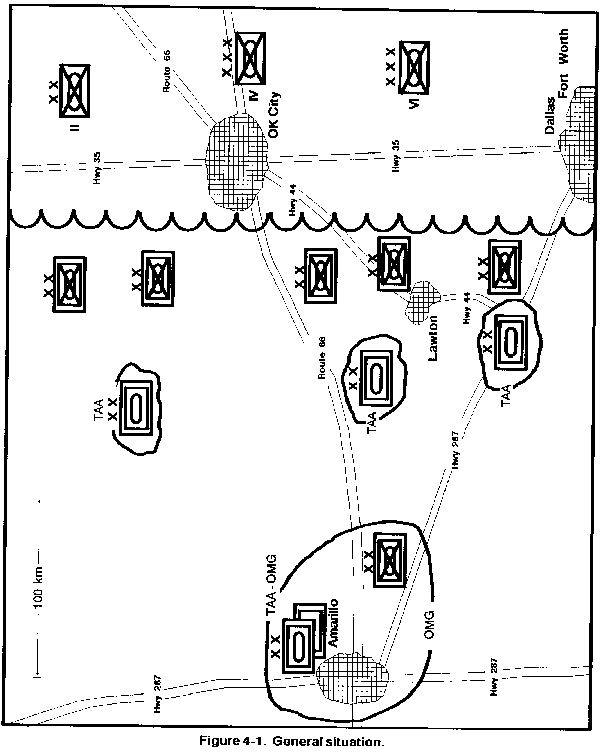
After receiving the commander's initial guidance,
the staff develops potential friendly COAs. One of these, COA
CORMIER, is shown in Figure 4-2.
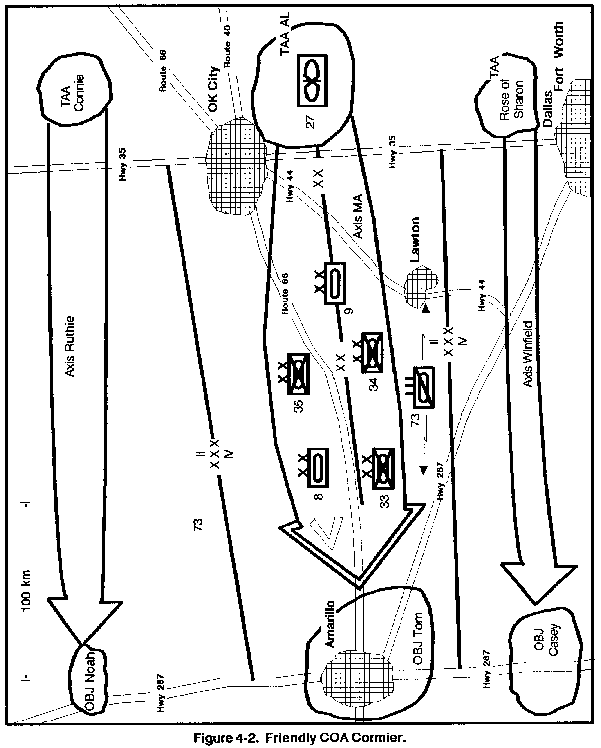
The staff then wargames each potential friendly
COA against each potential enemy COA developed by the intelligence
staff as part of the IPB process. During wargaming the staff identifies
times and places where expected battlefield events will prompt
decisions to engage targets or execute branches to the main COA.
They record these decisions, and the event that triggers them,
on the BOS synchronization matrix.
While wargaming COA CORMIER against the set of
enemy COAs, the staff determines that key to mission success is
delaying, disrupting, and then blocking any counterattacks by
the enemy's operational reserves (see Figure 4-3).
Accordingly, COA CORMIER includes several options for interdicting
and then blocking the enemy's operational reserves. Four of these
are shown on the partial BOS synchronization matrix (see Figure 4-4).
The staff identifies the intelligence required to support these
decisions as recommended PIR.

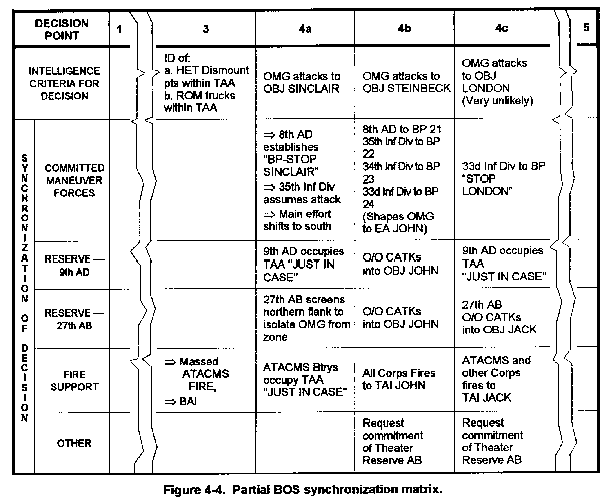
After comparing COA CORMIER to all other potential
friendly COAs, the staff recommends its adoption to the commander.
After he approves the recommendation, the staff begins detailed
planning to implement his decision.
Collection management began in the mission analysis
phase of the decision making process with initial requirements
focused on intelligence to support IPB and development of potential
friendly COAs. Collection management planning to support specific
friendly COAs began during the staff wargaming (COA comparison).
When the commander selected COA CORMIER as the command's COA,
the collection manager began developing the details of the collection
plan.
Referring to the BOS synchronization matrix,
the requirements manager identifies the intelligence required
to support each decision expected to occur during mission execution.
These become the basis of the corps' list of
intelligence requirements. To the corps' own requirements are
added those of higher and lower units. The requirements manager
prioritizes the complete list, using the planned phases of COA
CORMIER to "time phase" the requirements (see Figure 4-5).
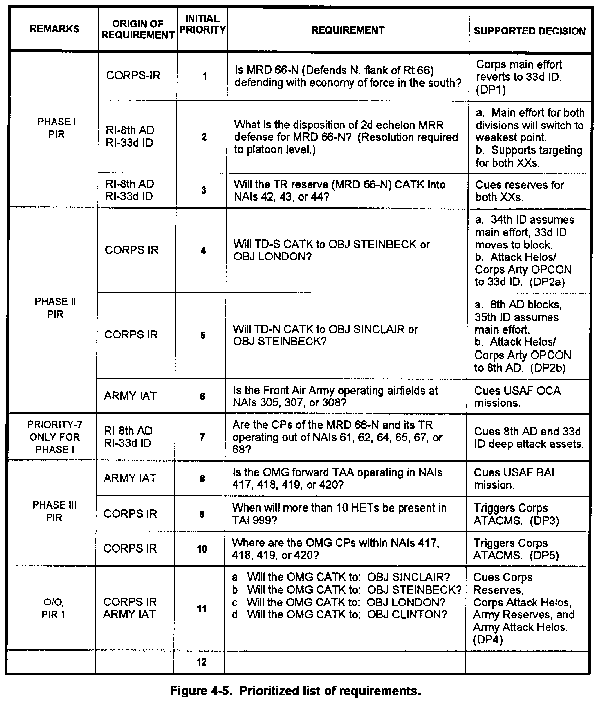
To further develop the corps intelligence requirements,
the requirements manager refers to the event template that supports
COA CORMIER (see Figure 4-3). The
NAIs it depicts tell him where to collect in order to satisfy
each intelligence requirement, while the event matrix tells him
what type of activity (indicator) is associated with each NAI
(see Figure 4-6).
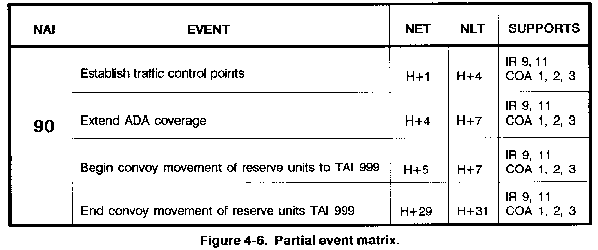
For each prioritized requirement, the corps requirements
manager works with ACE analysts to identify SRs that will satisfy
each indicator. SIRs, if satisfied, will answer the original requirement,
potentially providing more, and more relevant, information than
initially requested.
Using PIR #9 (see Figure 4-5)
as an example, Figure 4-9 shows the
relationship of PIR to indicators and SIRs as displayed on the
corps collection plan.
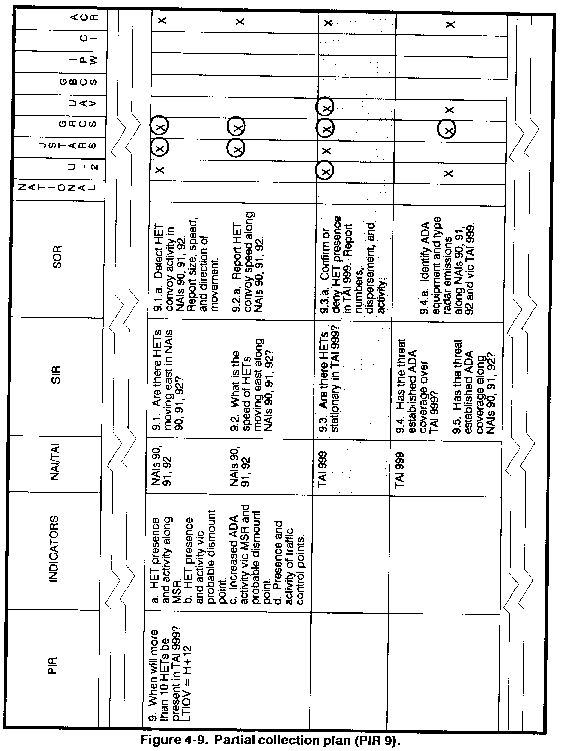
The quality and completeness of the corps' threat
data base and threat models contribute to building better focused
SIRs. SIRs, in turn, provide the corps mission manager his starting
point for asset evaluation.
The mission manager begins by evaluating the
general ability of each collection discipline to satisfy each
SIR. Again using PIR #9 as an example, Figure 4-7
depicts the asset evaluation worksheet the mission manager used
to evaluate collectors against one SIR.
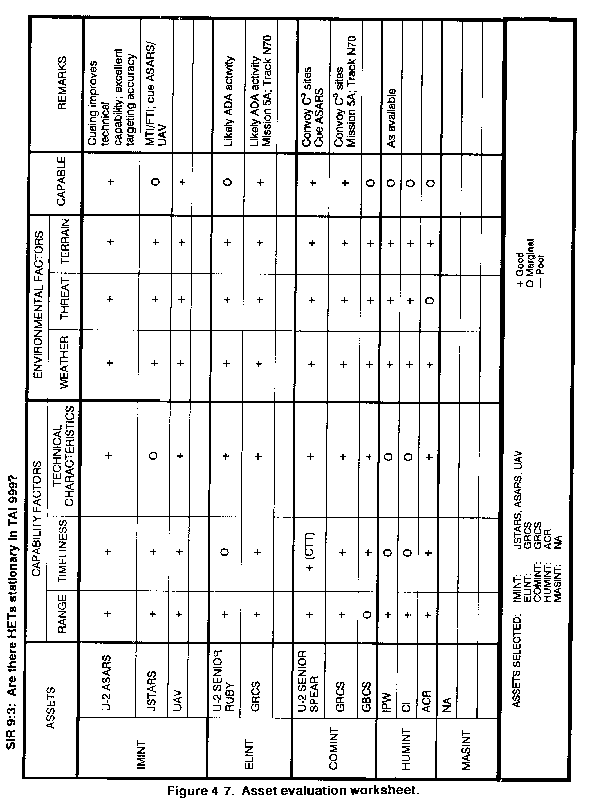
The mission manager then lists the assets to
which he has access by discipline. At this point in the process,
availability at a specific time is not the issue. Remember, the
corps collection manager can often directly influence asset availability.
Operation PLAINS PUSH does not enjoy national
systems collection priority; concurrent crises in other theaters
have won the competition for coverage. Therefore, the mission
manager does not "evaluate" that capability, although
he may include "National" on the collection plan in
case priorities change. The corps does, however, have NRT access
to U-2 ASARS/Senior Spear data via TRAC and commander's tactical
terminal (CTT).
The mission manager notes the capability of each
system to satisfy the specific requirement to locate stationary
heavy equipment transporters or associated activity that might
tip off another collector. Target selection criteria, in termsof location accuracy and reporting timeliness, are key considerations
in evaluating the collector's capability.
For example, GRCS could intercept a convoy movement
controller's radio transmission indicating off-loading activity.
This could cue the mission manager to redirect a UAV flight to
determine the precise location of the off-loading activity.
Similarly, although Joint STARS fixed target
indicator capability is limited, tracking moving targets into
the TAI could help focus the ASARS high-resolution fixed target
indicator capability. A direct cue from the GSM to TRAC makes
this work. (A GSM remote workstation and the presence of the MI
Brigade S3 in the ACE creates an optimum environment for this
kind of dynamic cueing by significantly reducing reaction and
retasking time.) Thus, in addition to evaluating individual asset
capability, the worksheet can form the first outline of a collection
strategy resulting in specific asset selection.
Now the mission manager must match the collectors
best suited to satisfy the SIRs against the corps' operational
and DP timelines. The ISM does just that (see Figure 4-8).
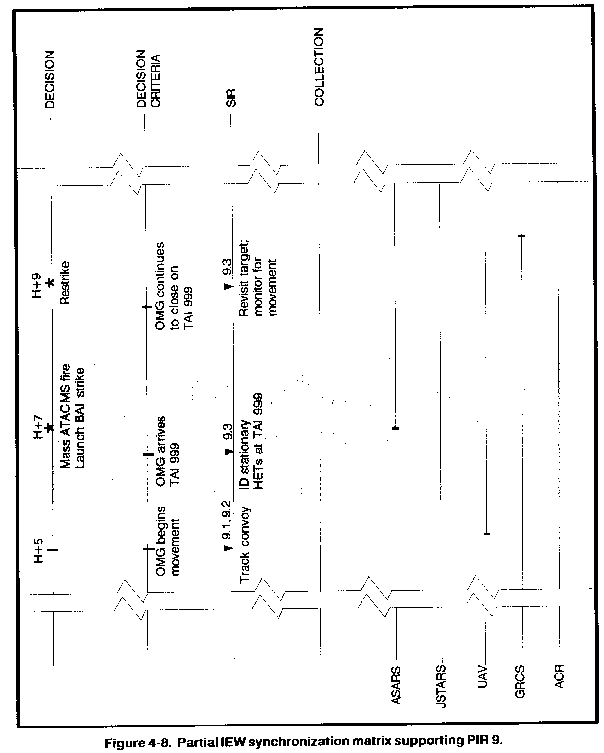
The mission manager plans for corps organic collectors
(UAV, GRCS, and the ACR) to provide redundant coverage during
scheduled theater missions. This significantly increases the opportunity
for cueing and is resource-smart since striking the enemy's operational
reserves early is critical to the corps commander's plan.
Once the collection strategy for all requirements
is synchronized with the timelines of COA CORMIER, the mission
manager develops the supporting SOR and assigns them to the assets
he has entered on the collection plan. Figure 4-9
depicts one technique for distinguishing between capable and less
capable collectors. The mission manager uses a "circle X"
to easily recognize the sources and systems for which he plans
to draft SORs.
The collector type and its required tasking format
determine which data elements are required to initiate collection.
In this example, the IV Corps mission manager executes IMINT and
SIGINT MATMs (Figures 4-10 and 4-11)
to task the UAV and GRCS. The MATM applies to Joint STARS as well,
but U-2 ASARS requires use of a Form 1684. Specific direction
in the intelligence annex takes the place of a machine-generated
message format for tasking the corps' ACR.
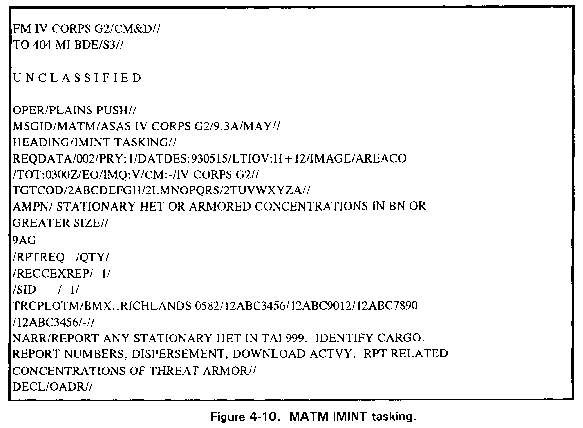
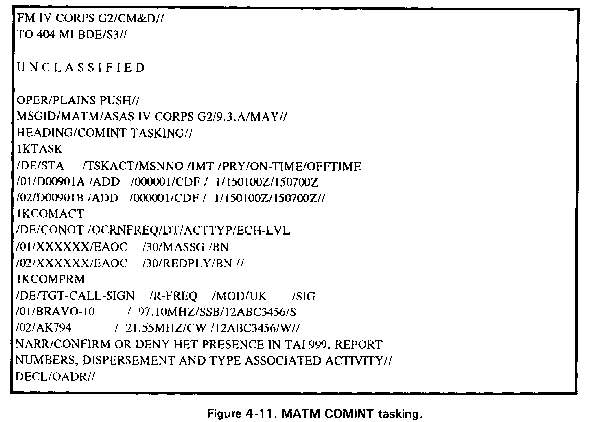
Once the mission manager completes and transmits
each task or request, the appropriate asset manager begins to
plan and execute the collection operation that will satisfy each
requirement. Subsequently, the CM&D section starts receiving
results in system-specific formats. The UAV RECCEXREP and GRCS
TACREP (Figures 4-12 and 4-13,
respectively) provide confirmation of heavy equipment transporter
dismount activity at TAI 999.
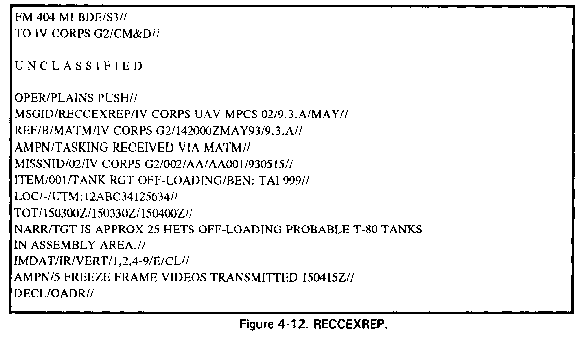

The requirements manager immediately passes this
critical targeting information to the target nomination team.
The corps commander has the intelligence he needs to execute the
ATACMS strike. In this example, the time lag between report evaluation
and dissemination disappears.
PIR #9 is an internal corps requirement; therefore,
further dissemination is probably not required. The requirements
manager notifies the mission manager that SIR 9.3.a remains active
to support restrike options until LTIOV. This requires continued
monitoring and revisiting the target area.
Let's look at another example not directly tied
to a targeting decision. PIR #11.a (see Figure 4-5)
concerns the potential counterattack OBJ of the enemy's operational
reserves. Figures 4-14 through 4-16
demonstrate the collection management process as it progresses
through the requirements and mission management functions.
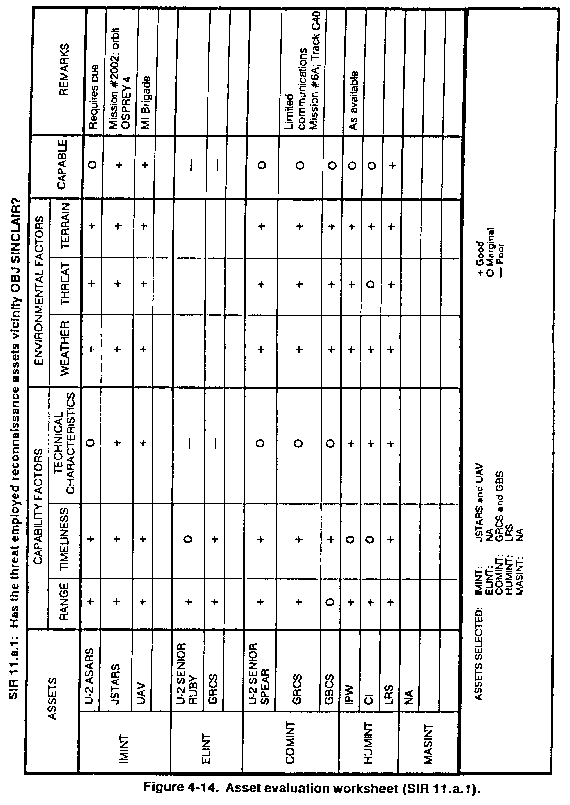
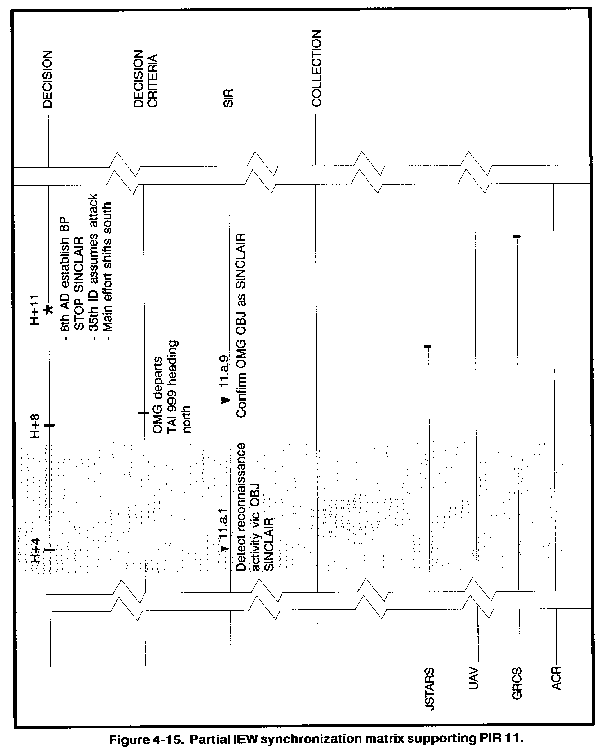
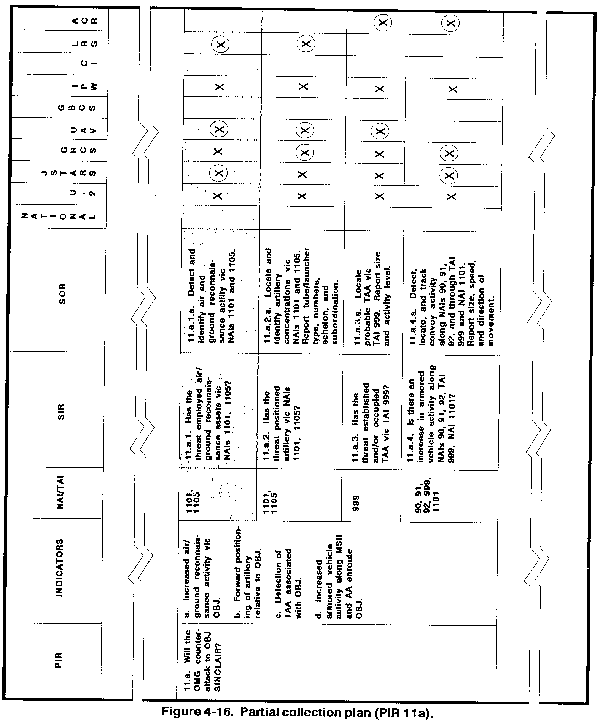
Highlighting SIR 11.a.1 (see Figure 4-16)
on reconnaissance activity, the mission manager recognizes the
value of a long-range surveillance unit (LRSU) insertion in support
of this requirement. NRT reporting and geolocational accuracy
are not high priority capability criteria in this case. The mission
manager evaluates and selects assets capable of collecting against
mobile air and ground reconnaissance (Figure 4-14),
synchronizes collection (Figure 4-15),
and completes the collection plan (Figure 4-16).
The mission manager elects to use a FRAGO (Figure 4-17)
to task the LRS company and specifies spot report as the reporting
format (Figure 4-18). He updates the
collection plan to reflect the changes in his collection strategy
(Figure 4-19).
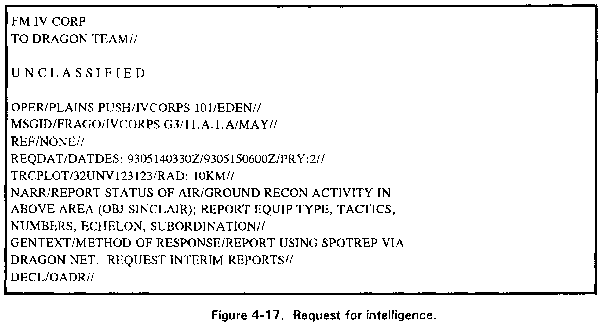
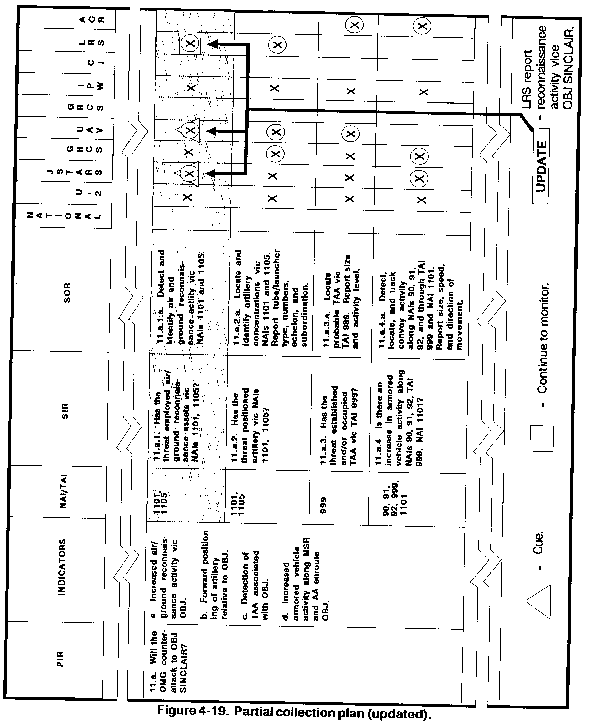
He intends to use the LRS company reporting to
cue UAV and Joint STARS for bigger pictures of the OBJ area. When
the report arrives (see Figure 4-18),
the requirements manager evaluates it and determines that continued
monitoring is required and disseminates the data within the ACE
and to the Army of the Red River.
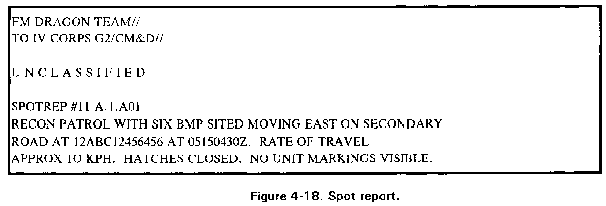
The IV Corps attack demands continuous coverage
of fixed and moving targets across a wide area. The corps is equipped
to conduct collection through efficient exploitation of the ISOS.
Scenario Two - Brigade
Force Projection (Peacekeeping)
A diplomatic envoy from the United Nations (UN)
has successfully negotiated a truce between the four warring factions
of Outremer, a former satellite of the Soviet Union whose "national
government" is crumbling. The month-old truce, however, is
endangered by the actions of the warlord ruler of Reynald, a small
but economically important province which controls Outremer's
major port and trade routes (see Figure 4-20).
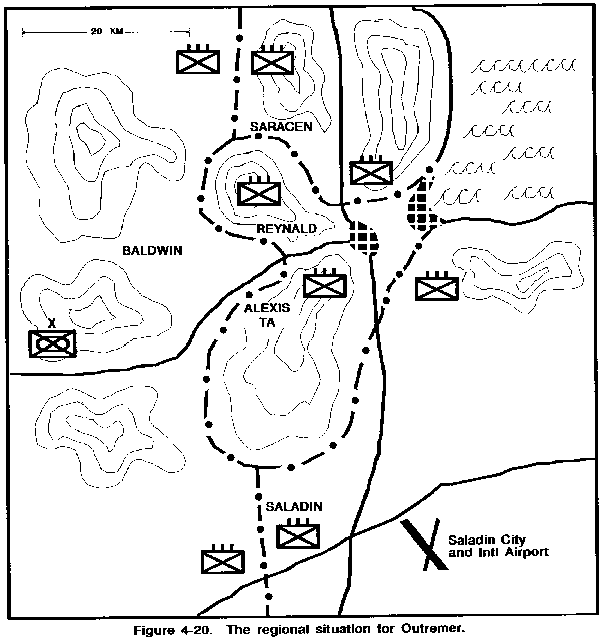
Regular plundering of trade between the provinces
of Saracen and Saladin by Reynald's military has heightened regional
tensions. These two Muslim provinces have threatened to re-invade
Reynald and establish a corridor across the predominantly Christian
province in order to safeguard their convoys. Because of the influence
of religion on regional politics, any such move would force the
Christian province of Baldwin to support Reynald, effectively
re-igniting the four-year civil war that killed or starved 75,000
people.
Outremer military forces within the region consist
of both regular and militia forces . Reynald's military consists
of one active duty infantry regiment and two militia regiments.
The active duty regiment is garrisoned in the two major cities
on the coastal plain (Kerak and Montreal). Ostensibly responsible
for maintaining law and order and protecting the province's borders,
it is this regiment which interferes with trade between the two
Muslim provinces. Although the two militia regiments in the mountainous
regions of Reynald were demobilized a month ago, they could be
quickly re-activated.
Baldwin's military includes the Tancred Brigade,
a mechanized infantry brigade and the region's only "heavy"
force, garrisoned at Fort Pilgrim in the western reaches of the
province. The Tancred Brigade often deploys to the Alexis Training
Area on Baldwin's border with Reynald, and at times trains within
the mountainous regions of western Reynald.
The remainder of the forces in the region are
the regular infantry regiments that Baldwin, Saracen, and Saladin
post along their borders for security and early warning.
In a last-ditch effort to stave off war, the
otherwise impotent "national government" of Outremer
requested the use of UN forces in Reynald to monitor and enforce
Reynaldian compliance with the terms of the truce, which include
free trade across provincial boundaries.
1st Brigade will participate as part of a US
JTF in this mission, deploying by air to Saladin City and then
moving overland into Reynald as the JTF's initial entry force.
1st Brigade's mission is to prevent the two Reynald militia regiments
from interfering with UN operations within the cities of Kerak
and Montreal. Figure 4-21 depicts
the JTF's organization and the 1st Brigade's intelligence architecture.
The remainder of the JTF will deploy by sealift to the port of
Hattin in Saladin over the next six weeks, moving overland to
join the 1st Brigade in Reynald (see Figure 4-22).
The mission of the 2d Brigade (ARFOR) and a Marine Brigade under
NAVFOR control is to monitor the activities of the Reynaldian
Regiment near Kerak and Montreal as well as to assist with UN
operations within those cities (see Figure 4-23).

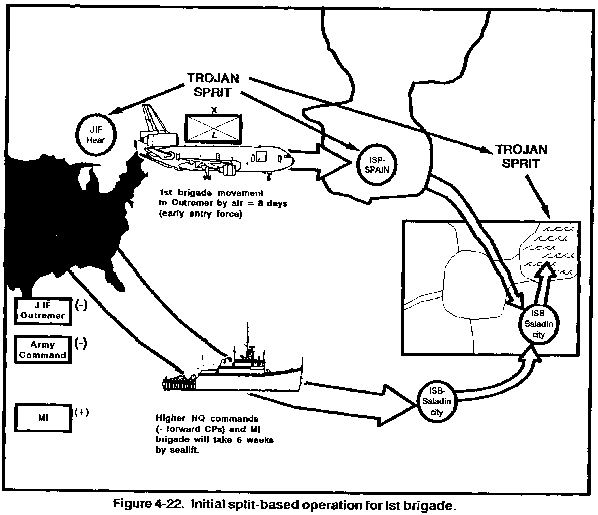
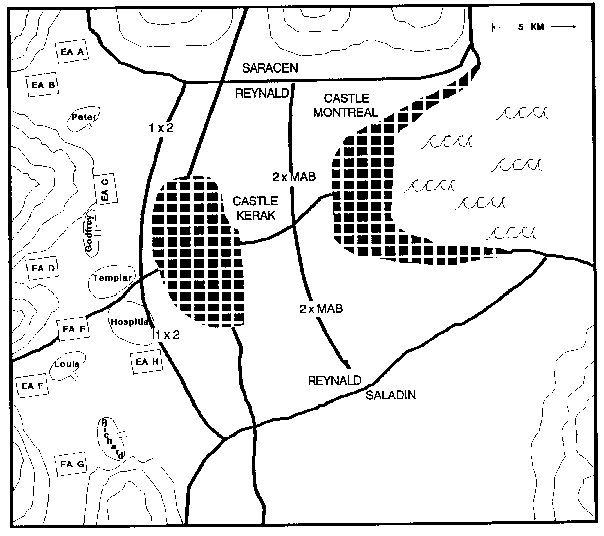
During predeployment planning, the JTF considered
airlifting the MI Brigade processors to the staging area in Spain.
However, the J2 decided to rely upon the in-place European theater
processors (IPDS and EPDS) and to augment each brigade with a
remote communications secondary imagery dissemination (SID) server.
The 1st Brigade, as the early entry force, receives a Trojan Spirit
equipped with an analytical software package that allows stand-alone
operations until the MI Brigade ACE arrives.
The national system has been monitoring the major
cities, Port Montreal, and Saladin City International Airport
in support of UN negotiations. In preparation for the 1st Brigade
and subsequent JTF deployment, the JTF collection manager "pulls"
current photograph coverage of the area of operation (AO). In
response to a 1st Brigade requirement, the JTF requests a DIA
photographic mosaic of the terrain west of Kerak to assist in
base camp planning.
After wargaming the force protection mission,
the JTF collection manager seeks CI support from the theater MI
Brigade for the intermediate staging area in Spain. Unfortunately,
HUMINT collection in the target area is virtually nonexistent.
The collection manager submits a time sensitive collection request
for HUMINT support for operations in the target area.
These actions are all part of pre-deployment
planning. The JTF collection manager and brigade S2 follow the
collection management process, although they may not generate
any traditional tools (asset evacuation worksheet, ISM, collection
plan) at this stage.
During the IPB process, the brigade's S2 determined
that Reynald would mobilize its militia if it intended to confront
the JTF with force. Accordingly, he identified the avenues of
approach that would allow the militia to move into the coastal
zone (see Figure 4-24).
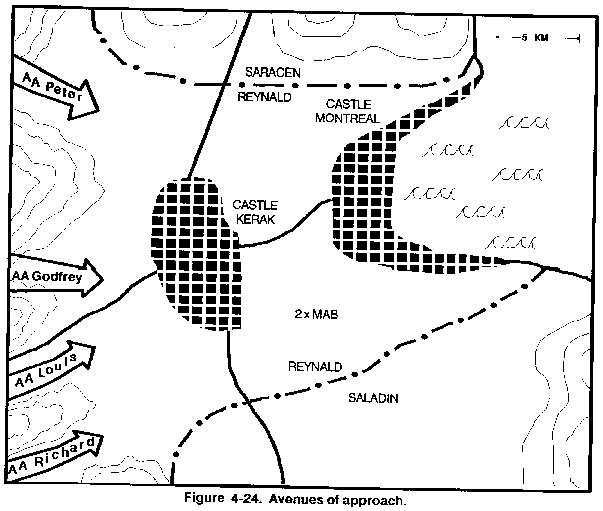
After wargaming potential friendly COAs against
the possible COAs of Reynald's militia, 1st Brigade's commander
plans to occupy BASE HOSPITLAR and BASE TEMPLAR (see Figure 4-23)
while monitoring the activities of Reynald's military forces.
Upon indications of intervention by Reynald's two militia regiments,
1st Brigade will respond by occupying battle positions and initiating
a set of confrontation procedures designed to intimidate Reynald's
government and avert armed conflict. Should this fail, the 1st
Brigade will activate designated engagement areas and destroy
any intervening forces. The location of the battle positions and
engagement areas is keyed to the COA Reynald's forces adopt (see
Figure 4-25).

In order to support the commander's decisions
on which battle positions and engagement areas to activate, the
S2 gets the commander's approval to implement the intelligence
requirements shown in Figure 4-26.

The S2 then develops a collection strategy designed
to determine whether Reynald's militia regiments intend to intervene
with UN operations within the province. Figure 4-27
illustrates the partial ISM which depicts his strategy for accomplishing
this in AA PETER.
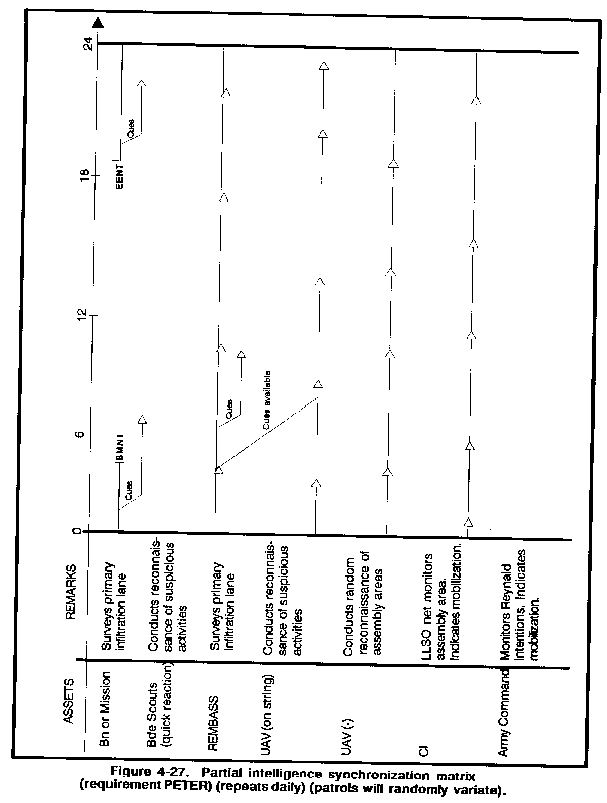
For the same area, the S2 refines the event template
to focus his collectors to specific areas within the avenue of
approach (see Figure 4-28). The locations
of the NAI are carefully chosen to provide enough information
to satisfy the requirements while also giving the commander enough
time to make a decision and move forces to appropriate battle
positions.
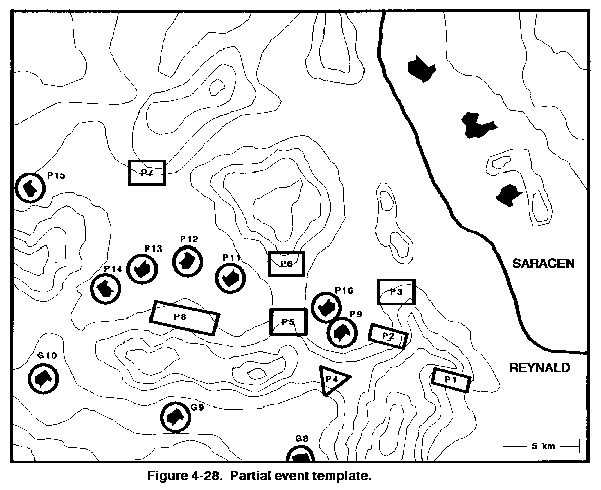
He then develops detailed taskings for collection
assets to implement the collection strategy described above. He
reflects these taskings in the collection plan shown in Figure 4-29.
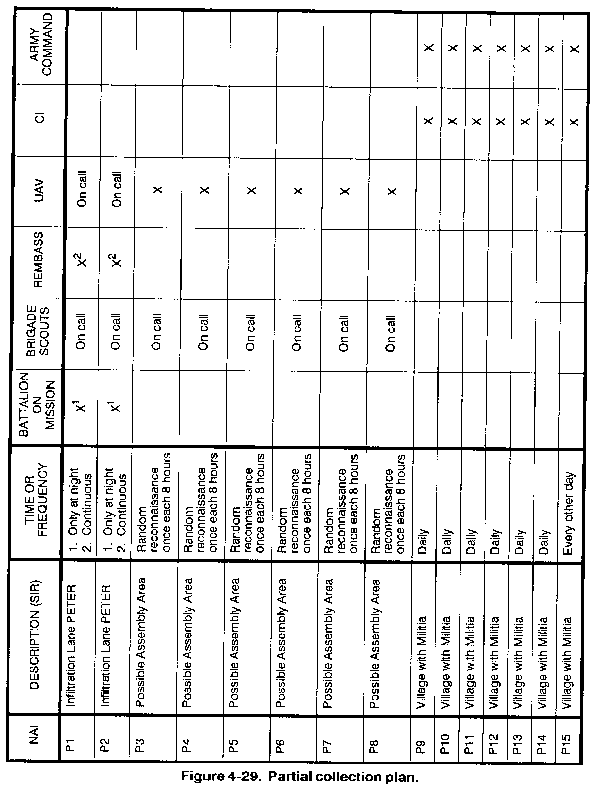
The brigade S2 coordinates with the JTF J2 to
ensure that he is planning intelligence collection against the
Tancred Mechanized Brigade. After corrdinating with the J2, the
S2 uses the Trojan Spirit to issue an exploitation requirement
prioritizing theater IPDS read out imagery of the Tancred Mechanized
Brigade in garrison and in the Alexis Training Area (Figure 4-30).
The IPDS responds with an Imagery Interpretation Report (IIR)
(Figure 4-31) that indicates the Tancred
Mechanized Brigade is conducting routine garrison operations.
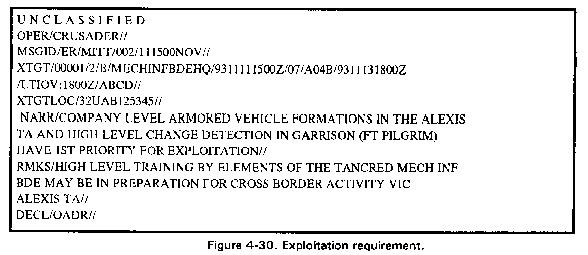
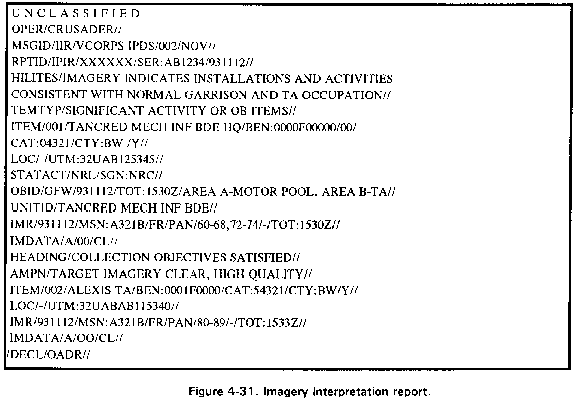
After each of the brigade's subordinate collection
assets receive their taskings, they in turn develop detailed R&S
plans to accomplish their taskings. The brigade S2 collects these
plans, verities that they will indeed satisfy his taskings, and
publishes them as a consolidated R&S plan (see Figures 4-32
and 4-33). This ensures that each
asset is aware of the others' activities and informs the friendly
force of the location of these deployed assets, significantly
reducing the risks of fratricide.

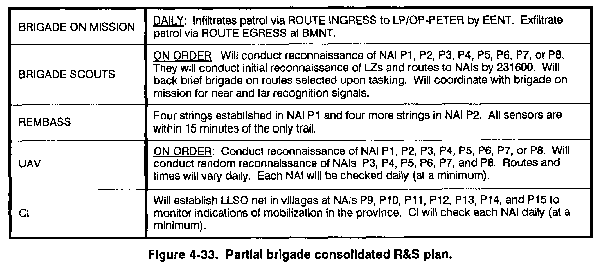
After executing these plans for 12 days, a remotely
monitored battlefield sensor system (REMBASS) operator delivers
the report shown at Figure 4-34 to
the brigade's S2 officer on duty:

In response, the S2 duty officer coordinates
with the S3 to air insert the brigade scouts into landing zone
(LZ) SOUTH and have them conduct reconnaissance along ROUTE C
to further investigate activities in NAI P2 (see Figure 4-33).
He also diverts an ongoing UAV mission to the NAI. The UAV reports
"no significant activity" in NAI P2. The scouts report
the only activity in the area to be grazing by a large number
of sheep and request permission to conduct foot reconnaissance
through NAI P1 on their return to base. The S2 recommends approval
of their request and coordinates for their passage through NAI
P1.
The next day the S2 queries the CI teams working
the villages near NAI P2 and learns that sheep are often permitted
to graze the mountain pass in the evenings. Accordingly, he updates
his collection plan to include visual observation of NAI P2 in
order to avoid constant false alarms.